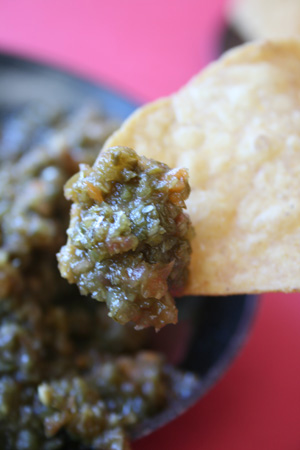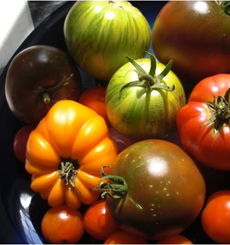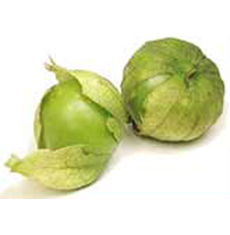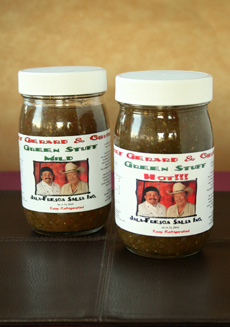 |
 |
Tomato salsa: the healthiest dip in the world. Photo by Jim Jurica | IST. |
| WHAT IT IS: Fresh salsa or salsa cruda, the original form of America’s favorite condiment. |
| WHY IT’S DIFFERENT: Packaged fresh or pasteurized, salsa is antioxidant-rich: full of healthy lycopene, vitamin A, vitamin B6 (which helps to convert carbohydrate into fuel for the body) and vitamin C . |
WHY WE LOVE IT: Flavor, versatility and low calories. The health benefits are a plus. |
| WHERE TO BUY IT: At almost every grocer in America. |
|
|
 |
 Salsa Verde: Green Salsa Is Another Reason To Dance Salsa Verde: Green Salsa Is Another Reason To Dance
Salsa Verde Overview
In his greater Los Angeles neighborhood, there was no paucity of salsa. But Chuck Turbush wanted something different, and began to make his own salsa—salsa verde. Jala-Fresca* was born, and became the item to look for at family gatherings. Friends loved it.
*Jala for the jalapeño, fresca for the fresh (uncooked) sauce.
With the growing clamor for salsa in the marketplace, Chuck’s son, Chef Gerard Turbush, added some sophisticated tweaks to Dad’s recipe by adding several degrees of spiciness and refining the flavor.
The product became a hit, and is carried at fine food stores throughout the Los Angeles area. It’s also available to order online. The label calls it Green Stuff.
And, this unorthodox salsa verde contains no tomatillos! The ingredients are red tomatoes, green onions, jalapeño, cilantro, garlic and sea salt. (The sauce is green, as you can see in the photo, but dotted with bits of tomato.)
Tomatillos or not, this refreshing, spicy salsa verde, nicely garlicky, can’t help but attract admirers like us, looking for a new, fat-free, sugar-free sauce for five calories a tablespoon. How could we resist?
Use it as you would red salsa. Think of it as the difference between Dijon mustard and German mustard.
We enjoy it straight as a sauce and mixed with nonfat Greek yogurt as a diet dip. The Mild was plenty spicy for us—a nice burn without numbing the taste buds. But, we disclaim, we’re from New York City and don’t eat a hot and spicy diet.
But as long as we’re on the topic of tomatoes and tomatillos, what’s the difference?
Find out as the article continues below.
|
| |
|
|
INDEX OF REVIEW
This is Page 2 of a two-page review. Click on the black links below to visit other pages:
|
MORE TO DISCOVER
|
The Difference Between Tomatoes & Tomatillos
Tomatillos are not little green tomatoes. Here’s the difference:
Tomato
The tomato is an edible red berry, although some varieties grow in colors that range from brown to green (when ripe), orange, purple-black, purple-blue, white and yellow (see photo below and learn more about tomato colors).
- Originally tiny in size (like the grape tomato), it was cultivated over centuries to its current “beefsteak” heft.
- Its botanical family is Solanaceae (the Nightshade family, which includes potatoes and eggplant), species/genus Solanum lycopersicum.
- The plant is native to Central and South America, from Mexico to Peru.
- It’s an annual plant with a woody stem that typically grows to 3 to 10 feet in height.
|
|
 A bevy of heirloom tomatoes in different colors. Photo courtesy Suncadia.com. A bevy of heirloom tomatoes in different colors. Photo courtesy Suncadia.com. |
Tomatillo
The tomatillo is also an edible berry. Small and spherical, it is [erroneously] called a green tomato; and also a husk tomato, a Mexican tomato and other names. But it’s a distant cousin to the tomato. Instead, it is closely related to the cape gooseberry.
Like the orange gooseberry, the tomatillo is surrounded by a papery husk. The ripe fruit can be green, purple, red or yellow.
- The tomatillo’s botanical family is also Solanaceae, but it belongs to a completely different species from the tomato, Physalis. Its botanical name is Physalis ixocarpa.
- Native to Central America, the tomatillo was a staple of Maya and Aztec cuisine.
- The tomatillo is also an annual plant, with a semi-woody stem that can grow to a height of 4 to 5 feet. However, it usually grows low to the ground and spreads out instead of up.
|
|
 The tomatillo. You can see from the paper husk that it’s not a close relative of the tomato. Photo courtesy CDC.gov. The tomatillo. You can see from the paper husk that it’s not a close relative of the tomato. Photo courtesy CDC.gov. |
On Super Bowl Sunday, set out both salsa roja and salsa verde, and take a vote.
| JALA-FRESCA SALSA Salsa Verde in Mild, Medium, Hot and Blazing Hot
Made with red tomatoes, green onions, jalapeño, cilantro, garlic and sea salt.
Fat free and sugar free.
Available at fine food stores throughout the Los Angeles area and online.
JalaFresca.net |
|
 Mild and Hot flavors of Jala-Fresca Chef Gerard & Chuck Green Stuff. Photo by River Soma | THE NIBBLE. Mild and Hot flavors of Jala-Fresca Chef Gerard & Chuck Green Stuff. Photo by River Soma | THE NIBBLE.
|
Do you have friends who would enjoy THE NIBBLE?
Click here to send them an invitation to sign up for their own copy. |
© Copyright 2004-2025 Lifestyle Direct, Inc. All rights
reserved. All information contained herein is subject to change at any time
without notice. All details must be directly confirmed with manufacturers, service
establishments and other third parties. The material in this e-zine may not
be reproduced, distributed, transmitted, cached, or otherwise used, except with
the prior written permission of Lifestyle Direct, Inc.
|
|

|
 |